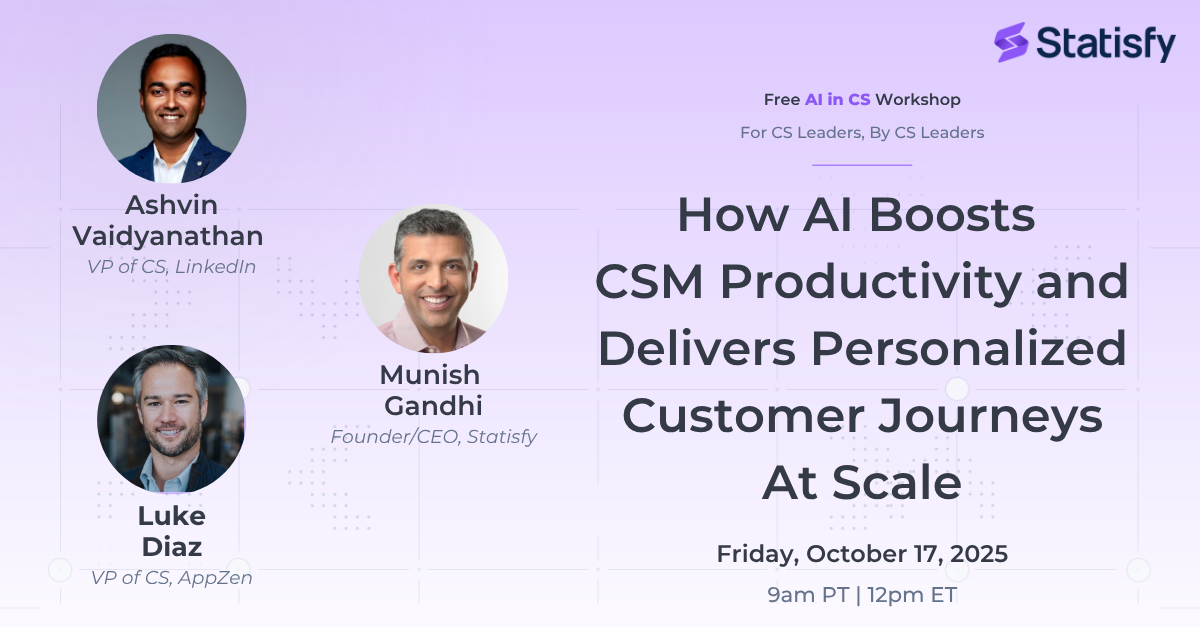
See the October 17th Webinar Summary
Here


Thank you to Ashvin and Luke for sharing your AI journey to date!

Check out
Statisfy's AI-generated Session Summary:

Vendor positioning and the core problem statement
Manish (Statisfy CEO) framed the problem Statisfy addresses: customer success teams are burdened by manual data entry, fragmented customer information, and lack of usable signals from unstructured sources such as meeting transcripts and emails. He explained Statisfy’s vision as an AI-native customer intelligence layer that consolidates customer data, extracts insights, and organizes CSM workloads so teams operate on signals rather than cadence-driven routines. This sets the stage for why AI-first architectures can deliver different outcomes compared with legacy CS platforms.
Framework for prioritizing AI work in Customer Success
Ashvin described a two-by-two decision framework used at LinkedIn to prioritize AI efforts: one axis is customer value add of an activity and the other is automation potential (driven by data availability). They target activities with high automation potential and lower direct customer-facing value first (e.g., prep, research, slide generation) then move toward higher customer-value tasks. Applying this framework, LinkedIn focused on adoption/success reviews and broke down the time CSMs spend: investigating current state and creating presentation materials consumed roughly half of the effort, making these high-return targets for automation.
Concrete AI use cases and implementations
Ashvin and Manish detailed three core implementations: (1) Automated two-page dossiers that synthesize internal signals and external market context prior to customer meetings, saving ~1 hour/month per account for CSMs; (2) An internal conversational search over a repository of case-study Word documents so CSMs and other teams can quickly find similar use cases and impacts; (3) Dynamic, personalized one-to-many email generation for scaled outreach (e.g., seat adoption nudges) with benchmark-aware messaging and human review to prevent hallucinations before sending. These features were iteratively piloted (starting with Sales Solutions at LinkedIn and SMB segments) and expanded based on outcomes and feedback.
Risk detection and account prioritization (AppZen use cases)
Luke (AppZen) explained why AppZen chose Statisfy—its AI-first architecture and ability to surface signals buried in calls and emails. He described an automated risk-flagging pipeline that ingests meeting transcripts and other touchpoints, detects trigger phrases (e.g., competitor mentions, RFP, model performance concerns), and auto-generates risk flags for leadership review. He also showed an account-prioritization agent that produces dynamic weekly digests highlighting what changed and which accounts require immediate action, enabling CSMs to prioritize with higher signal-to-noise.
Outcomes, metrics and adoption approach
Speakers emphasized an experimentation-first rollout: start with a focused business line or segment, iterate quickly, and expand on success. LinkedIn measured outcomes by human efficiency gains and behavioral metrics—personalized emails yielded a 20–40% increase in product usage among recipients. AppZen highlighted improved coaching and faster access to product feedback (real quotes for product team use). Statisfy cited a customer expecting a 2-point improvement in GRR and CSMs reporting they can handle ~20% more accounts due to time saved.
Future opportunities: up-skilling, product feedback loops, and scale
Ashvin highlighted future directions including real-time coaching bots for CSM upskilling, expanding agent usage analytics to understand which AI actions drive adoption, and strengthening the CS–Product feedback loop by surfacing structured defects/enhancements from conversational data. Luke noted the value of an objective AI foil to contrast with optimistic human CSM judgments, improving one-on-ones and coaching recency.
Check out
Statisfy's AI-generated Session Summary:
